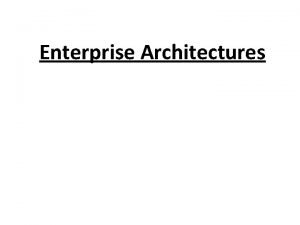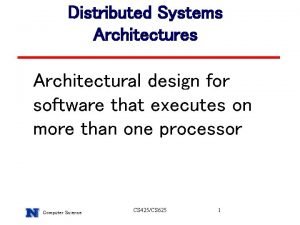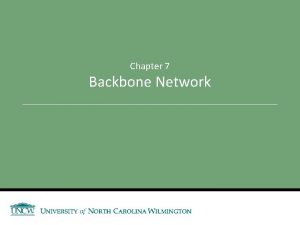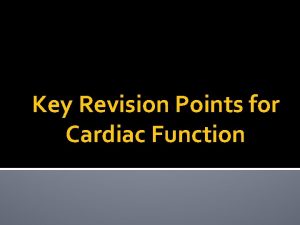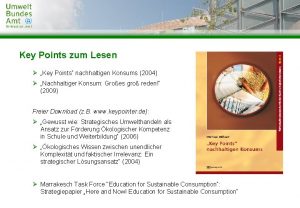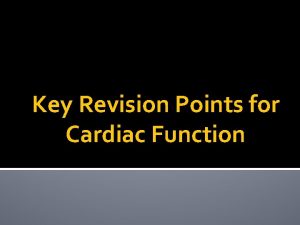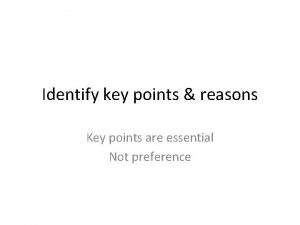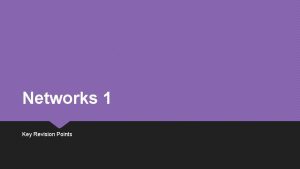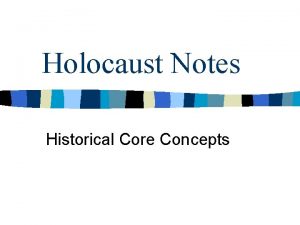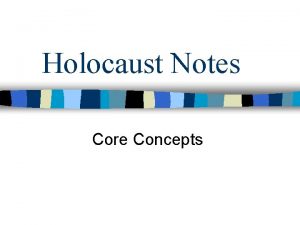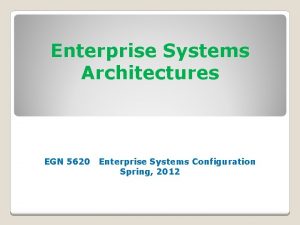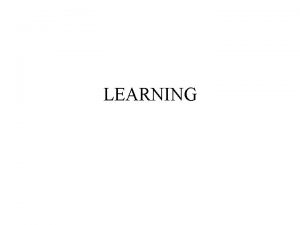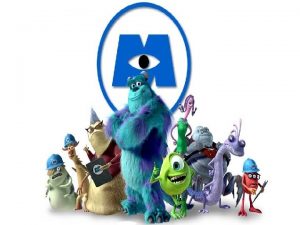Enterprise Architectures Core Concepts Key Learning Points This



















- Slides: 19

Enterprise Architectures

Core Concepts Key Learning Points: This chapter will help you to answer the following questions: • What are the ADM phase names and the purpose of each phase? • What are deliverables, artifacts, and building blocks? • What is the Enterprise Continuum? • What is the Architecture Repository? • How to establish and operate an enterprise architecture capability?

What is ADM? The Architecture Development Method (ADM) provides a tested and repeatable process for developing architectures. The ADM includes establishing an architecture framework, developing architecture content, transitioning, and governing the realization of architectures. All of these activities are carried out within an iterative cycle of continuous architecture definition and realization that allows organizations to transform their enterprises in a controlled manner in response to business goals and opportunities.

What are the Phases of the ADM? The ADM is described as a number of phases within a process of change illustrated by an ADM cycle graphic (see following). Phases within the ADM are as follows: Preliminary Phase - describes the preparation and initiation activities. Phase A: Architecture Vision - describes the initial phase of an Architecture Development Cycle. Phase B: Business Architecture - describes the development of a Business Architecture to support an agreed Architecture Vision Phase C: Information Systems Architectures - describes the development of Information Systems Architectures for an architecture project, including the development of Data and Application Architectures. Phase D: Technology Architecture - describes the development of the Technology Architecture for an architecture project.

Phase E: Opportunities and Solutions - conducts initial implementation planning and the identification of delivery vehicles for the architecture defined in the previous phases. Phase F: Migration Planning - addresses the formulation of a set of detailed sequence of Transition Architectures with a supporting Implementation and Migration Plan. Phase G: Implementation Governance - provides an architectural oversight of the implementation. Phase H: Architecture Change Management - establishes procedures for managing change to the new architecture. Requirements Management - examines the process of managing architecture requirements throughout the ADM.

The ADM Cycle

Core Concepts: Deliverables, Artifacts, and Building Blocks • A deliverable is a work product that is contractually specified and in turn formally reviewed, agreed, and signed off by the stakeholders. Deliverables represent the output of projects and those deliverables that are in documentation form will typically be archived at Completion of a project, or transitioned into an Architecture Repository as a reference model, standard, or snapshot of the Architecture Landscape at a point in time.

Core Concepts: Deliverables, Artifacts, and Building Blocks • An artifact is a more granular architectural work product that describes an architecture from a specific viewpoint. Examples include a network diagram, a server specification, a use-case specification, a list of architectural requirements, and a business interaction matrix. Artifacts are generally classified as catalogs (lists of things), matrices (showing relationships between things), and diagrams (pictures of things). An architectural deliverable may contain many artifacts and artifacts will form the content of the Architecture Repository.

Core Concepts: Deliverables, Artifacts, and Building Blocks • A building block represents a (potentially re-usable) Component of business, IT, or architectural capability that can be combined with other building blocks to deliver architectures and solutions. Building blocks can be defined at various levels of detail and can relate to both architectures and solutions, with Architecture Building Blocks (ABBs) typically describing the required capability in order to shape the Solution Building Blocks (SBBs) which would represent the components to be used to implement the required capability.

Figure: Relationships between deliverables, artifacts, and building blocks

Core Concepts: The Enterprise Continuum TOGAF includes the concept of the Enterprise Continuum, shown in following Figure , which sets the broader context for an architect and explains how generic solutions can be leveraged and specialized in order to support the requirements of an individual organization. The Enterprise Continuum is a view of the Architecture Repository that provides methods for classifying architecture and solution artifacts as they evolve from generic Foundation Architectures to Organization-Specific Architectures. The Enterprise Continuum comprises two complementary concepts: the Architecture Continuum and the Solutions Continuum.

Figure: The Enterprise Continuum

Core Concepts: The Architecture Repository The major components within an Architecture Repository are as follows: • The Architecture Metamodel describes the organizationally tailored application of an architecture framework, including a metamodel for architecture content. • The Architecture Capability defines the parameters, structures, and processes that support governance of the Architecture Repository. • The Architecture Landscape shows an architectural view of the building blocks that are in use within the organization today (e. g. , a list of the live applications). The landscape is likely to exist at multiple levels of abstraction to suit different architecture objectives. • The Standards Information Base (SIB)7 captures the standards with which new architectures must comply, which may include industry standards, selected products and services from suppliers, or shared services already deployed within the organization. • The Reference Library provides guidelines, templates, patterns, and other forms of reference material that can be leveraged in order to accelerate the creation of new architectures for the enterprise. • The Governance Log provides a record of governance activity across the enterprise.

Figure: TOGAF Architecture Repository Structure

Establishing an Operational Architecture Capability An enterprise architecture practice must be run like any other operational unit within a business; i. e. , it should be treated like a business. To this end, and over and above the core processes defined within the ADM, an enterprise architecture practice should establish capabilities in the following areas: • Financial Management • Performance Management • Service Management • Risk Management • Resource Management • Communications and Stakeholder Management • Quality Management • Supplier Management • Configuration Management • Environment Management

Summary This chapter has introduced the core concepts of TOGAF. This has included the following: • The ADM and the purpose of each phase • The concepts of deliverables, artifacts, and building blocks, and how they relate to the outputs of the ADM • The Enterprise Continuum as a concept, and how it is used to classify artifacts • The Architecture Repository and how it is used to store different classes of architectural output • How to establish and maintain an enterprise architecture capability, and the guidelines available within TOGAF • How to operate an architecture capability, including a list of recommended capabilities beyond the ADM

Test Yourself Questions Q 1: Which of the TOGAF Architecture Development phases is the initial phase of an Architecture Development Cycle? A. Preliminary Phase B. Phase A C. Phase B D. Phase C E. Phase D Q 2: Which of the TOGAF Architecture Development phases provides oversight of the implementation? A. Phase D B. Phase E C. Phase F D. Phase G E. Phase H

Test Yourself Questions Q 3. Which of the TOGAF Architecture Development phases includes the creation and approval of the Architecture Vision document? A. Preliminary Phase B. Phase A C. Phase B D. Phase C E. Phase D Q 4. Which of the following is not a phase of the ADM? A. Preliminary B. Phase C: Requirements Architecture C. Phase F: Migration Planning D. Phase D: Technology Architecture E. Phase G: Implementation Governance

Recommended Reading Foundation Study Guide of TOGAF Version - 9 Chapter - 03 Provided as a. pdf document
 Autoencoders, unsupervised learning, and deep architectures
Autoencoders, unsupervised learning, and deep architectures Key learning point
Key learning point Fundamental and incidental interactions
Fundamental and incidental interactions Database storage architecture
Database storage architecture Ansi sparc
Ansi sparc Switched backbone networks
Switched backbone networks George schlossnagle
George schlossnagle Architecture
Architecture Gui architectures
Gui architectures Database system architectures
Database system architectures Cdn architectures
Cdn architectures Scalable web architectures
Scalable web architectures Data warehouse architecture types
Data warehouse architecture types Isa instruction set architecture
Isa instruction set architecture Browser/server architecture
Browser/server architecture Banking system architecture diagram
Banking system architecture diagram Backbone network architectures
Backbone network architectures Cache coherence for gpu architectures
Cache coherence for gpu architectures Why systolic architectures
Why systolic architectures Bullseye positioning model
Bullseye positioning model

